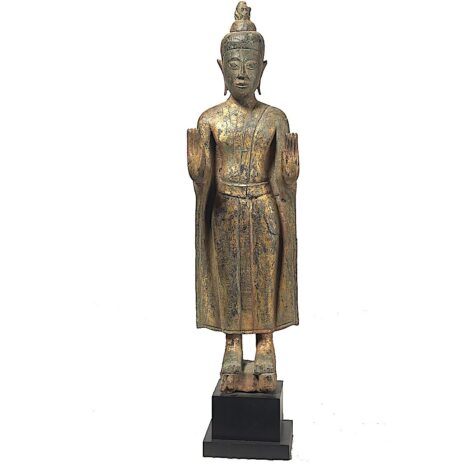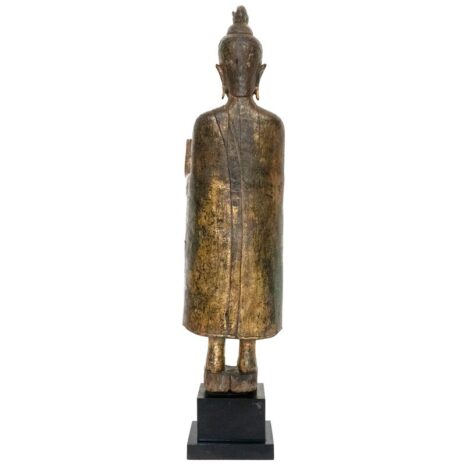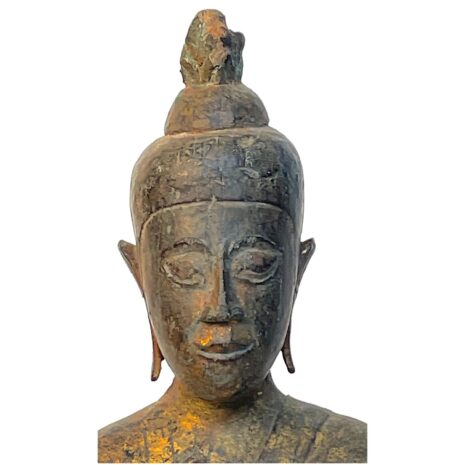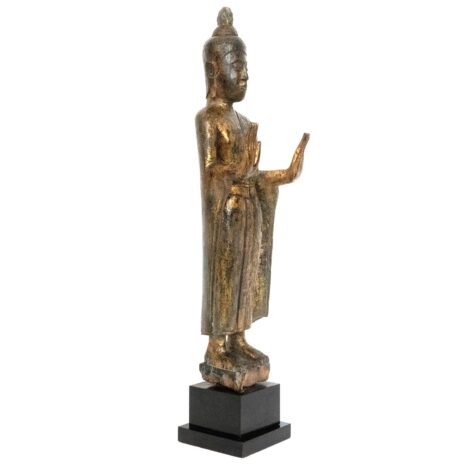Antique Buddha in Freedom from Fear, Laos (3148)
Original price was: $1,475.00.$1,195.00Current price is: $1,195.00.
H: 20″ W: 3.75 D: 3.75″ | CALL 213-568-3030 OR EMAIL [email protected] FOR SHIPPING.
Rare antique, wood Theravada Lao Buddha in abhaya mudra symbolizing reassurance, divine protection, and dispelling fear. Gilt paint reflects his golden skin.
Description
This uplifting wood Lao Buddha reflects the Theravada Buddhist traditions practiced in Southeast Asia that closely follows proscribed cannons in ancient texts. Lao sculpture stylistically resembles Northern and Northeastern Thailand in which Buddha images visually and symbolically reflect perfection, representing his spiritual and physical ideal after many life times of virtuous deeds. Following traditional iconography, Theravada Buddha images generally display many of 32 major marks of the great man (lakshanas).
Many of these physical features are seen in this graceful statue: a fleshy protuberance (ushnisha) with a flame-shaped radiance that indicates his status as an Enlightened Being; elongated slender body and limbs, broad shoulders and arms extending below the knees, serene countenance with an aquiline nose and faint smile; extended earlobes lying flat against his face as a sign of his former life as a prince who wore heavy jewelry; golden skin and fingers and toes of equal length. His thin 3-part monks robe – outer garment, undergarment and shoulder wrap – signify his dedication and renunciation of worldly life.
As an extremely pious country, Buddhist statuary is visible everywhere in Laos, from elaborate temples to grottos to small home and community shrines and altars. Lao artisans are said to be in both a spiritual and mental state when carving Buddhist statues enabling them to visualize the ideal Buddhist reality. This produces a wide variety of artistic styles of all sizes and importance with no images being identical. Although the Buddha is not a deity, Lao Buddhists often seek to communicate with the supernatural world through Buddha statues by praying and making offerings to them.
Wood has been the preferred medium for centuries for large and small Buddha statues and has deep cultural significance, symbolizing not only the Buddha but also the faith, spiritual values, and artistic traditions of the Lao people. Wood carvings are often displayed in homes and offices, to bring good luck and prosperity. This provincial carving reflects the rich Laotian folk tradition where laypeople create wooden Buddha images in varying sizes, styles, forms and iconography. While some are plain wood, this is covered with a glowing gilt finish.
Laos and Thailand are unique in portraying the Buddha in abhaya mudra with both arms bent, palms outward with even length fingers. Referred to as “Freedom from Fear” or the “Gesture of Protection,” it symbolizes benevolence, protection, peace and dispelling fear representing Buddha’s fearlessness and spiritual power that he confers to devotees. t also is called the “Causing the Waters to Subside” or “Calming the Ocean” which symbolizes Buddha’s visit to Kasyapa an Indian monk who was giving sermons near a river that began to flood. The Buddha raised both arms and the floodwaters receded upon which Kasyapa and his followers converting to Buddhism.
This Buddha originally stood on a high platform which has been replaced with a stabilizing a new two-tier stand. Otherwise is in excellent condition with a dark patina showing its age.
Sources
Somkiart Lopetcharat, Lao Buddha, The Image and Its History, Bangkok, Siam International Book Company, Ltd, Thailand, 2000.
K.I. Matics, Gestures of the Buddha, Bangkok, Chulalongkorn University Press, 2001.
Additional information
| Place of Origin | Laos |
|---|---|
| Period | Antique (1200-1920) |
| Date | 18-19th Century |
| Materials and Technique | Wood |
| Dimensions (inches) | Ht: 20” W: 3.75” D: 3.75” |
| Dimensions (metric) | Ht: 50.80cm W: 9.52cm D: 9.52cm |
| Condition | Very good, see description |
| Item Number | 3148 LKE |
| Weight | 3lbs 7oz |
| Width | 0” to 5.9” |
| Shipping Box Size | Oversized. Call 213-568-3030 or email [email protected] for shipping. |










